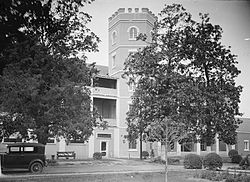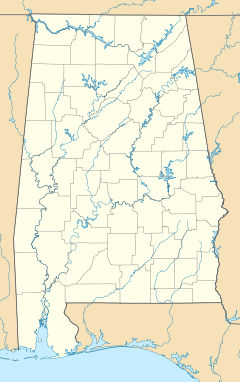- Mount Vernon Arsenal-Searcy Hospital Complex
-
Mount Vernon Arsenal-Searcy Hospital Complex
 The old barracks building in 1935
The old barracks building in 1935Nearest city: Mount Vernon, Alabama Coordinates: 31°5′16″N 88°1′43″W / 31.08778°N 88.02861°WCoordinates: 31°5′16″N 88°1′43″W / 31.08778°N 88.02861°W Architectural style: Classical Revival, Greek Revival Governing body: State NRHP Reference#: 88000676[1] Added to NRHP: May 26, 1988 The Mount Vernon Arsenal-Searcy Hospital Complex is a historic district listed on the National Register of Historic Places in Mount Vernon, Alabama, in Mobile County. It is currently home to Searcy Hospital, a state-owned and operated psychiatric hospital, and was formerly home to the Mount Vernon Arsenal, a United States Army munitions depot.
Contents
Mount Vernon Arsenal
The Mount Vernon Arsenal was a United States Army munitions depot, located on the Mobile River three miles west of Fort Stoddert, approximately 30 miles inland from the Gulf of Mexico near Mount Vernon, Alabama. Along with the Kennebec Arsenal in Augusta, Maine, it is one of the most complete antebellum arsenals surviving to the present day.[2] It was established by the United States Army in 1828 as an ordnance manufacturing base, the Mount Vernon Arsenal served as one of the US Army's main ammunition plants from its inception until the Civil War.
On January 4, 1861, troops of the Alabama state militia took possession of the arsenal on the orders of Alabama governor Andrew B. Moore.[3] The takeover from the small US Army force, commanded by Captain Jesse L. Reno, was peaceful and bloodless. After Alabama joined with other seceded states to form the Confederacy, the Arsenal was turned over to the Confederate Army for the duration of the war. In 1862, after the Battle of New Orleans, the Confederacy moved ammunition manufacturing from the Mount Vernon Arsenal to Selma, Alabama. Selma offered a more secure location farther away from Union forces.[4]
The Confederate Army held the Arsenal almost until the end of the Civil War. After the war was over, the Arsenal was returned to the federal government and the site was renamed the Mount Vernon Barracks. From 1887 to 1894 the Barracks was used as a prison for captured Apache people, including Geronimo and his followers. Walter Reed, the United States Army physician who confirmed that yellow fever is spread by mosquitoes, served as post surgeon in the 1880s. In 1895, the site was deeded to the state of Alabama.[5]
Searcy Hospital
In 1900, the Alabama Legislature established a mental health facility on the site to relieve overcrowding of Bryce Hospital in Tuscaloosa. The new facility was named the Mount Vernon Hospital upon its opening in 1902 but was renamed Searcy Hospital in 1919, in honor of Dr. J. T. Searcy, the first superintendent.[5] It served African-Americans exclusively until 1969, when it was desegregated following the Civil Rights Act of 1964.[6] On May 26, 1988, the Mount Vernon Arsenal/Searcy Hospital Complex was added to the National Register of Historic Places as a historic district. The district is made up of 25 buildings over 360 acres (146 ha), with nine of the structures dating from 1830s still in use.[7] Searcy Hospital currently has 408 extended-care beds and a 124-bed intermediate care unit for patients with severe mental illness. Patients are housed in modern buildings. It also serves the female forensic in-patient psychiatric center for the southern one-third of Alabama.[8]
See also
References
- ^ "National Register Information System". National Register of Historic Places. National Park Service. 2008-04-15. http://nrhp.focus.nps.gov/natreg/docs/All_Data.html.
- ^ National Historic Landmark Nomination - Kennebec Arsenal, p.20.
- ^ War of the Rebellion, Vol.I, Chap.III, p.327-328.
- ^ U.S. War Department, The War of the Rebellion: A Compilation of the Official Records of the Union and Confederate Armies, 70 volumes in 4 series. Washington, D.C.: United States Government Printing Office, 1880-1901.
- ^ a b "Historical Markers: Mobile County". Alabama Department of Archives and History. http://www.archives.alabama.gov/aha/markers/mobile.html. Retrieved 2009-01-30.
- ^ National Register of Historic Places[dead link]
- ^ Mobile County, AL Historic Districts
- ^ James F. Hooper. Forensic Psychiatry Resources, University of Alabama Department of Psychiatry & Neurology/Alabama Department of Mental Health & Retardation.
U.S. National Register of Historic Places Topics Lists by states Alabama • Alaska • Arizona • Arkansas • California • Colorado • Connecticut • Delaware • Florida • Georgia • Hawaii • Idaho • Illinois • Indiana • Iowa • Kansas • Kentucky • Louisiana • Maine • Maryland • Massachusetts • Michigan • Minnesota • Mississippi • Missouri • Montana • Nebraska • Nevada • New Hampshire • New Jersey • New Mexico • New York • North Carolina • North Dakota • Ohio • Oklahoma • Oregon • Pennsylvania • Rhode Island • South Carolina • South Dakota • Tennessee • Texas • Utah • Vermont • Virginia • Washington • West Virginia • Wisconsin • WyomingLists by territories Lists by associated states Other National Register of Historic Places in Mobile County, Alabama Historic districts Barr's Subdivision Historic District | Bellingrath Gardens and Home | Central Core Historic District | Chickasaw Shipyard Village Historic District | Citronelle Railroad Historic District | Davis-Oak Grove District | Grand Bay Historic District | Mount Vernon Arsenal-Searcy Hospital Complex

Other properties Hiram B. Austin House | Bishop Manor Estate | Willis G. Clark House | Ellicott Stone | Fort Gaines | Charles Denby Garrison Sr. House | Indian Mound Park | George Leatherbury House | Magee Farm | Middle Bay Light | Nanna Hubba Bluff | Old Mobile Site; Fort Louis De La Louisiane | Tanner Farmhouse | N.Q. and Virginia M. Thompson House
Mobile (city) Categories:- NRHP articles with dead external links
- Historic districts in Alabama
- Psychiatric hospitals in Alabama
- Hospitals established in 1902
- Alabama in the American Civil War
- United States Army arsenals
- American Civil War forts
- Historic districts in Mobile County, Alabama
- National Register of Historic Places in Mobile County, Alabama
- 1828 establishments in the United States
- Classical Revival architecture in Alabama
- Greek Revival architecture in Alabama
Wikimedia Foundation. 2010.

